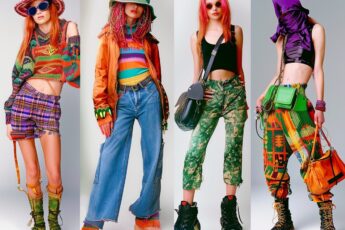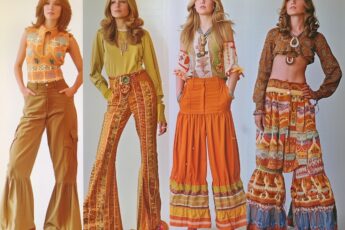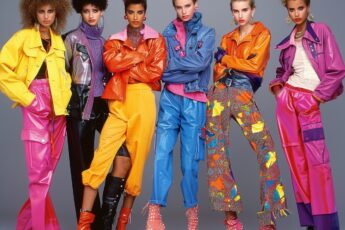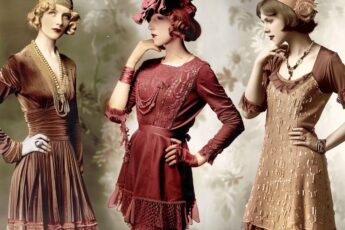1950s Fashion
The 1950s marked a turning point in fashion history. After World War II, fashion underwent a dramatic transformation. The decade saw a revival of elegance and a celebration of femininity.
As rationing ended and economies boomed, designers had more freedom to create. This led to exciting new styles and silhouettes. The 1950s gave us:
- The iconic “New Look”
- Teenage fashion revolution
- Rise of ready-to-wear clothing
One key aspect of 1950s fashion was its emphasis on the hourglass figure. Women’s clothing accentuated small waists and full hips, and men’s fashion, too, evolved significantly during this time.
Fashion is not something that exists in dresses only. Fashion is in the sky, in the street; fashion has to do with ideas, the way we live, what is happening.
This quote perfectly captures the spirit of 1950s fashion. It wasn’t just about clothes; it reflected societal changes and new ideas.
Hollywood played a crucial role in shaping fashion trends. Movie stars became style icons, influencing what people wore in their everyday lives.
The 1950s also saw the birth of youth culture. Teenagers began to develop their own unique styles, often rebelling against adult fashion norms, leading to exciting new trends and subcultures.
In the following chapters, we’ll explore these aspects of 1950s fashion. From haute couture to everyday wear, from accessories to hairstyles, we’ll explore how this decade shaped the way we dress today.
Post-War Influence on 1950s Fashion
The end of World War II sparked a fashion revolution. I’ve observed how the lifting of rationing and the surge in economic prosperity dramatically changed the fashion landscape.
As restrictions eased, designers eagerly embraced newfound freedom. They used more fabric, creating fuller skirts and elaborate designs. This shift marked a clear break from the utilitarian styles of the war years.
The post-war economic boom played a crucial role. People had more disposable income, and they spent it on clothes. This led to:
- Increased demand for ready-to-wear fashion
- Growth of the fashion industry
- Emergence of new design houses
The 1950s saw a return to glamour and femininity. Women who had worked in factories during the war embraced ultra-feminine styles. Men’s fashion, too, became more relaxed and varied.
Fashion is a form of ugliness so intolerable that we have to alter it every six months.
This quote reflects the rapid changes in 1950s fashion. Trends came and went quickly, fueled by growing consumerism and media influence.
Christian Dior’s New Look
Christian Dior’s “New Look” revolutionized fashion in 1947, setting the tone for 1950s style. I consider this one of the most significant fashion moments of the 20th century.
The New Look featured:
| Element | Description |
|---|---|
| Cinched waists | Achieved with corsets and waist-cinchers |
| Full skirts | Often using yards of fabric |
| Rounded shoulders | A softer look than 1940s sharp shoulders |
| Longer hemlines | A departure from wartime shorter skirts |
This style emphasized an hourglass silhouette, celebrating feminine curves. It was a stark contrast to the boxy, utilitarian styles of the war years.
Dior’s use of abundant fabric was almost shocking after years of rationing. Some criticized it as wasteful, but many women embraced the luxurious new style.
The New Look influenced fashion throughout the 1950s. Other designers created their own versions, and the style trickled down to ready-to-wear fashion.
Simplicity is the keynote of all true elegance.
This quote encapsulates the essence of Dior’s New Look. Despite its apparent extravagance, the style had a simple, elegant core that defined 1950s fashion.
Feminine Silhouettes
The 1950s celebrated the female form like never before. I’ve always been fascinated by how fashion in this era emphasized the hourglass figure. Designers created clothes that accentuated small waists, full busts, and rounded hips.
Key elements of the 1950s feminine silhouette included:
- Nipped-in waists
- Full, voluminous skirts
- Fitted bodices
- Rounded shoulders
To achieve this look, women relied on specific undergarments. Bullet bras gave the bust a distinctive pointed shape, and girdles and corsets cinched the waist, creating that coveted hourglass shape.
Here’s a quick breakdown of popular silhouettes:
| Style | Description |
|---|---|
| New Look | Tiny waist, full skirt |
| Pencil | Slim, fitted from bust to knee |
| Trapeze | Fitted shoulders, flared body |
| Sack | Loose-fitting, straight cut |
Dress shabbily and they remember the dress; dress impeccably and they remember the woman.
This quote captures the essence of 1950s fashion philosophy. The right silhouette could make a woman unforgettable.
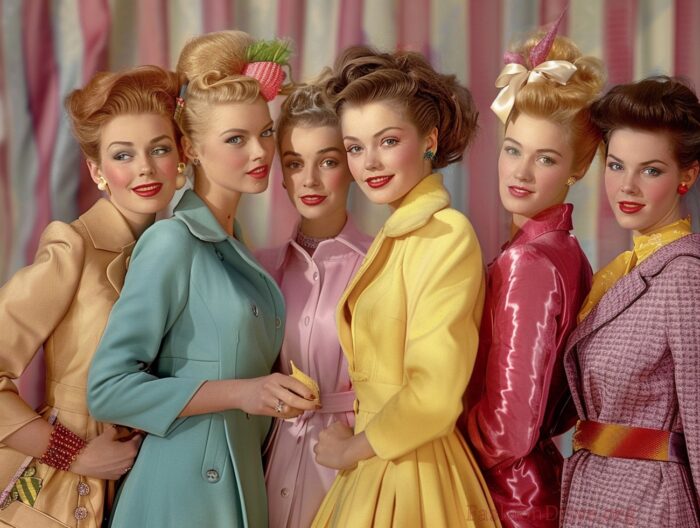
Men’s Fashion Evolution
Men’s fashion in the 1950s underwent significant changes. I find this evolution particularly interesting as it reflects broader societal shifts.
The gray flannel suit became a symbol of corporate America. It represented conformity and success in the business world. However, casual wear also gained popularity, especially among younger men.
Key trends in 1950s men’s fashion:
- Suits with narrow lapels and slim ties
- Sport coats paired with slacks
- Casual button-down shirts
- Leather jackets for a rebellious look
The rise of the Ivy League style influenced men’s fashion significantly. This preppy look included:
- Khaki chinos
- Oxford cloth shirts
- Penny loafers
- Letterman jackets
Casual Fridays weren’t a thing yet, but weekends saw men embracing more relaxed styles. Hawaiian shirts and bowling shirts gained popularity for leisure wear.
Looking good isn’t self-importance; it’s self-respect.
This quote reflects the 1950s attitude towards men’s fashion. While styles became more varied, there was still an emphasis on looking put-together and respectable.
Teenage Fashion Revolution
The 1950s saw the birth of youth culture, a phenomenon that fascinated me as I studied this era. Teenagers, with their increasing spending power and desire for self-expression, became a distinct fashion demographic for the first time.
Several factors drove this revolution in teenage fashion:
- Economic prosperity
- Rock ‘n’ roll music
- Hollywood teen idols
- Desire to rebel against adult norms
Teenage boys adopted looks inspired by icons like James Dean and Marlon Brando:
- Leather jackets
- White t-shirts
- Jeans
- Slicked-back hair
Girls embraced styles that set them apart from their mothers:
| Item | Description |
|---|---|
| Poodle skirts | Full circle skirts with appliqués |
| Bobby socks | Ankle socks often paired with saddle shoes |
| Pedal pushers | Calf-length trousers |
| Ponytails | Casual, youthful hairstyle |
Style is a way to say who you are without having to speak.
This quote perfectly captures the essence of teenage fashion in the 1950s. Young people used clothing to express their identity and values.
Hollywood’s Fashion Impact
Hollywood’s influence on 1950s fashion cannot be overstated. I’ve always been amazed by how thoroughly movie stars shaped the way people dressed during this decade.
Actresses like Audrey Hepburn, Marilyn Monroe, and Grace Kelly became style icons. Women around the world eagerly copied their on-screen and red-carpet looks.
Key Hollywood fashion influences included:
- Fitted sheath dresses
- Capri pants
- Ballet flats
- Cat-eye sunglasses
Male stars also had a significant impact. Cary Grant epitomized suave sophistication, while James Dean represented rebellious youth.
Hollywood costume designers played a crucial role in shaping fashion trends:
- Edith Head
- Helen Rose
- William Travilla
These designers created looks that were both glamorous and attainable, inspiring ready-to-wear fashion.
The best fashion show is definitely on the street. Always has been, and always will be.
This quote reflects how Hollywood fashion trickled down to everyday wear. People adapted glamorous looks for their daily lives, creating a unique street style influenced by the silver screen.
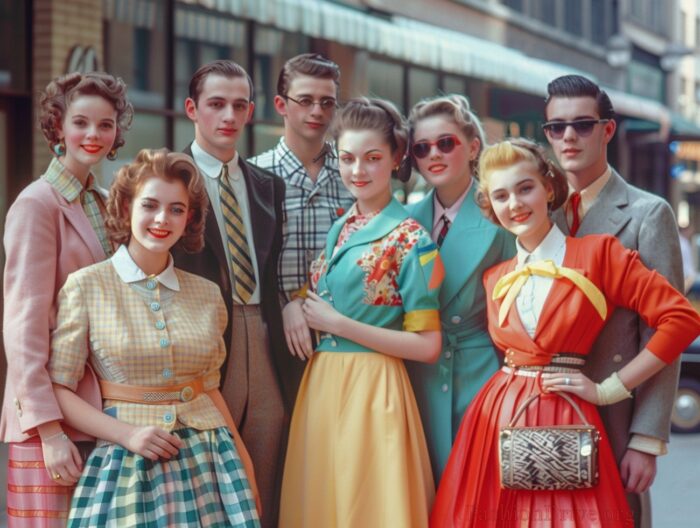
Accessories in the 1950s
Accessories played a crucial role in 1950s fashion. I’ve always been impressed by how these small details could completely transform an outfit. Women, in particular, used accessories to add flair and personality to their looks.
Key accessories of the era included:
- Gloves: Often elbow-length for evening wear
- Hats: From pillboxes to wide-brimmed styles
- Pearls: A symbol of elegance and refinement
- Cat-eye sunglasses: Dramatic and glamorous
- Stiletto heels: Sleek and feminine
Men’s accessories were more subdued but equally important:
| Accessory | Description |
|---|---|
| Tie clips | Kept narrow ties in place |
| Cufflinks | Added polish to dress shirts |
| Pocket squares | Provided a pop of color |
| Fedoras | Completed the business look |
Accessories are what, in my opinion, pull the whole look together and make it unique.
This quote encapsulates the importance of accessories in 1950s fashion. They allowed for personal expression within the confines of popular styles.
Fabric Innovations
The 1950s saw remarkable advancements in fabric technology. I find this aspect of fashion history particularly fascinating, as it revolutionized clothing production and wear.
Synthetic materials gained popularity during this decade:
- Nylon
- Acrylic
- Polyester
- Spandex
These new fabrics offered several advantages:
- Easier care
- Wrinkle resistance
- Durability
- Lower cost
Natural fibers weren’t forgotten. Cotton, wool, and silk remained popular, often blended with synthetics for improved performance.
Bold prints and patterns flourished in the 1950s:
| Pattern | Description |
|---|---|
| Polka dots | Playful and feminine |
| Gingham | Fresh and youthful |
| Floral | Romantic and sophisticated |
| Plaid | Sporty and casual |
Thanks to these fabric innovations, the concept of wash-and-wear clothing emerged. This convenience appealed to busy housewives and working women alike.
Fashion is not necessarily about labels. It’s not about brands. It’s about something else that comes from within you.
This quote reflects how fabric innovations allowed more people to express themselves through fashion, regardless of their budget or social status.
Sportswear and Casual Trends
The 1950s marked a significant shift towards more casual, comfortable clothing. I’ve always found this trend fascinating, as it reflected changing social norms and lifestyles. Sportswear became increasingly popular, blurring the lines between athletic clothing and everyday wear.
Key casual trends included:
- Capri pants
- Pedal pushers
- Hawaiian shirts
- Sneakers
Women embraced these comfortable options for leisure activities:
| Item | Description |
|---|---|
| Capri pants | Calf-length, slim-fitting trousers |
| Pedal pushers | Slightly longer than capris, often cuffed |
| Culottes | Wide-leg, split skirts |
| Wrap skirts | Easy to wear, adjustable fit |
Men’s casual wear evolved, too. Hawaiian shirts became a symbol of laid-back style, especially for summer and vacation wear. Polo shirts gained popularity as a more refined alternative to t-shirts.
Style is knowing who you are, what you want to say, and not giving a damn.
This quote captures the spirit of 1950s casual wear. People began to prioritize comfort and personal expression in their everyday clothing choices.
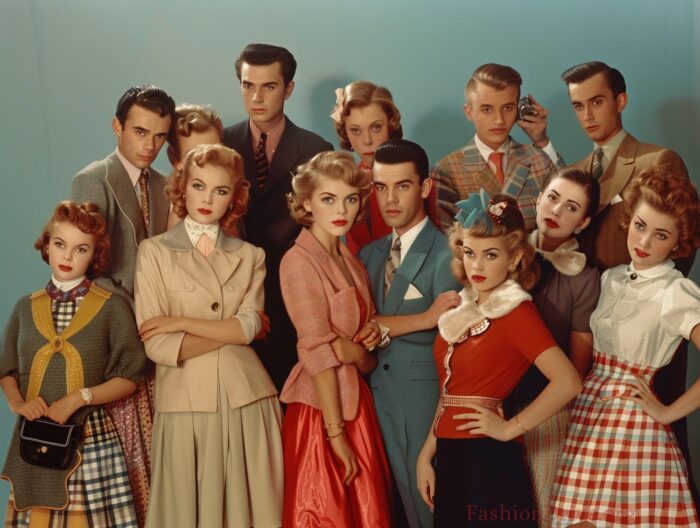
Haute Couture vs. Ready-to-Wear
The 1950s saw a fascinating tension between haute couture and ready-to-wear fashion. I’ve always been intrigued by how these two worlds influenced each other during this decade.
Haute couture remained the pinnacle of fashion:
- Exclusive designs
- Handmade garments
- Fitted to individual clients
- Extremely expensive
Paris fashion houses dominated the haute couture scene:
However, ready-to-wear clothing gained significant ground:
| Advantage | Description |
|---|---|
| Affordability | Mass-produced, lower prices |
| Accessibility | Available in department stores |
| Variety | More options for different tastes |
| Convenience | No fittings required |
Department stores played a crucial role in bringing fashion to the masses. They often created their own lines inspired by haute couture designs. Mail-order catalogs also expanded access to fashionable clothing for those outside urban centers.
Fashion is not something that exists in dresses only. Fashion is in the sky, in the street, fashion has to do with ideas, the way we live, what is happening.
This quote reflects the democratization of fashion in the 1950s. While haute couture set trends, ready-to-wear brought those trends to a wider audience and shaped the way people dressed in their everyday lives.
Subcultures and Alternative Styles
The 1950s weren’t all poodle skirts and gray flannel suits. I’ve always been fascinated by the alternative styles that emerged during this decade. These subcultures challenged mainstream fashion and paved the way for future style rebellions.
Three key subcultures stood out:
- Beatniks
- Greasers
- Early rock ‘n’ roll enthusiasts
The Beatniks embraced a bohemian aesthetic:
- Black turtlenecks
- Berets
- Slim-fit pants
- Sandals or bare feet
Greasers, on the other hand, cultivated a tough, working-class image:
| Item | Description |
|---|---|
| Leather jackets | Often adorned with studs or patches |
| White t-shirts | Tight-fitting, sometimes rolled sleeves |
| Blue jeans | Cuffed at the ankle |
| Boots or Converse sneakers | Sturdy footwear for a rugged look |
Early rock ‘n’ roll fashion blended elements from both these styles, adding bright colors and bold patterns. Elvis Presley’s gold lamé suit is a prime example of this flamboyant trend.
To be yourself in a world that is constantly trying to make you something else is the greatest accomplishment.
This quote captures the spirit of these subcultures. They used fashion as a form of self-expression and rebellion against societal norms.
Color Palettes of the 1950s
Color played a crucial role in 1950s fashion. I’ve always been struck by the decade’s distinctive palette, which ranged from soft pastels to vibrant primaries. These colors reflected the optimism and energy of the post-war era.
Popular color schemes included:
- Pastel hues
- Bold primaries
- Black and white contrast
Pastel colors dominated women’s fashion:
- Baby blue
- Mint green
- Pale pink
- Lavender
Men’s fashion tended towards more muted tones, but casual wear embraced brighter hues:
| Color | Usage |
|---|---|
| Charcoal gray | Business suits |
| Navy blue | Casual jackets |
| Burgundy | Accessories |
| Mustard yellow | Casual shirts |
The black and white trend made a strong statement in both men’s and women’s fashion. It appeared in everything from evening gowns to casual separates.
The best color in the whole world is the one that looks good on you.
This quote reflects the 1950s approach to color. While certain hues were trendy, people increasingly chose colors that complemented their individual looks.
Designers used color blocking and contrasting patterns to create visual interest. Polka dots, gingham, and bold floral prints added vibrancy to 1950s wardrobes.
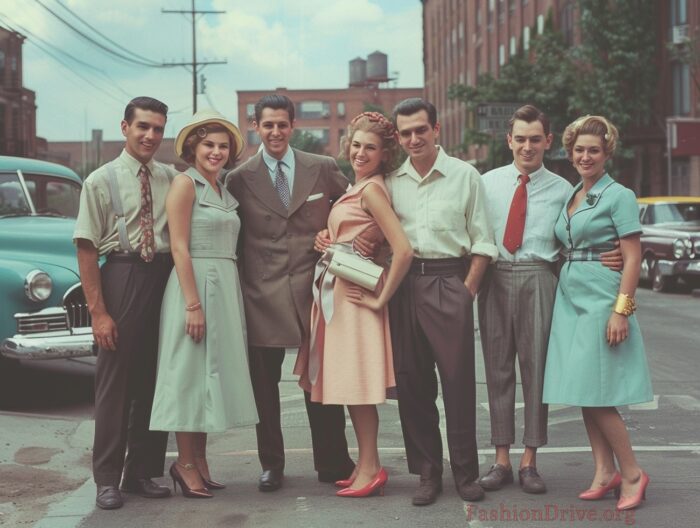
Hairstyles and Beauty Standards
The 1950s brought dramatic changes to hairstyles and beauty standards. I’ve always been fascinated by how these trends reflected the decade’s emphasis on femininity and glamour.
Popular women’s hairstyles included:
- Poodle cuts: Short, curly, and voluminous
- Pin curls: Tight, neat curls pinned close to the head
- Bouffants: Teased, high-volume styles
- Ponytails: Youthful and practical
Men’s hairstyles also evolved:
| Style | Description |
|---|---|
| Pompadour | Swept up and back, often with grease |
| Crew cut | Short all over, military-inspired |
| Slick back | Smooth and shiny, combed straight back |
Makeup trends emphasized a flawless complexion and bold lips. Women aimed for:
- Matte Foundation
- Winged eyeliner
- Red lipstick
- Groomed, arched eyebrows
Beauty tools and products gained popularity:
- Hair rollers
- Hairspray
- Liquid eyeliner
- Cream blush
The most beautiful makeup of a woman is passion. But cosmetics are easier to buy.
This quote captures the 1950s attitude towards beauty. While natural beauty was valued, women embraced cosmetics to enhance their features.
Global Fashion Influences
The 1950s saw an increasing globalization of fashion. I’ve always been intrigued by how international influences shaped the decade’s style. Three key regions made significant impacts:
- Italy
- Asia
- America
Italian design gained prominence:
- Slim-fit suits
- Fine leather goods
- Elegant knitwear
Asian influences brought new elements to Western fashion:
| Element | Description |
|---|---|
| Mandarin collars | Standing collars on dresses and jackets |
| Kimono-inspired robes | Loose, flowing house wear |
| Silk brocades | Rich, textured fabrics in clothing and accessories |
American style, meanwhile, spread globally:
- Jeans
- T-shirts
- Casual sportswear
Hollywood played a crucial role in exporting American fashion. Films and magazines showcased US styles to international audiences.
Fashion is not something that exists in dresses only. Fashion is in the sky, in the street, fashion has to do with ideas, the way we live, what is happening.
This quote reflects the growing interconnectedness of global fashion in the 1950s. Styles from different cultures began to blend, creating new and exciting trends.
Designers increasingly looked abroad for inspiration. This cultural exchange enriched 1950s fashion, setting the stage for the even more diverse styles of the 1960s.
Conclusion
The 1950s laid the foundation for modern fashion as we know it today. I’ve spent years studying this era, and its influence continues to amaze me. This decade blended tradition with innovation, creating styles that remain relevant decades later.
Key takeaways from 1950s fashion:
- Emphasis on feminine silhouettes
- Rise of youth culture and casual wear
- Technological advancements in fabrics
- Globalization of style
The fashion industry evolved significantly during this time:
| Aspect | Change |
|---|---|
| Production | Mass manufacturing increased |
| Distribution | Department stores and catalogs expanded |
| Marketing | Hollywood and media influence grew |
These changes democratized fashion, making stylish clothing more accessible to the masses.
Fashion fades, only style remains the same.
This quote encapsulates the lasting impact of 1950s fashion. While specific trends have come and gone, the fundamental styles and attitudes toward clothing established in this decade continue to shape how we dress today.
The 1950s marked a pivotal moment in fashion history. It set the stage for the rapid changes of the 1960s and beyond, while establishing enduring classics that we still wear and admire.
